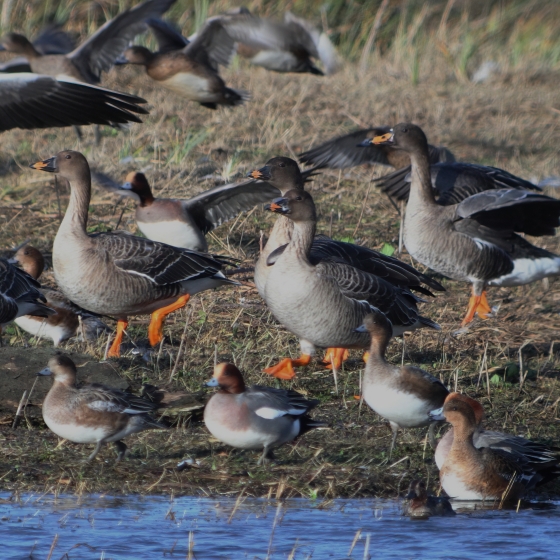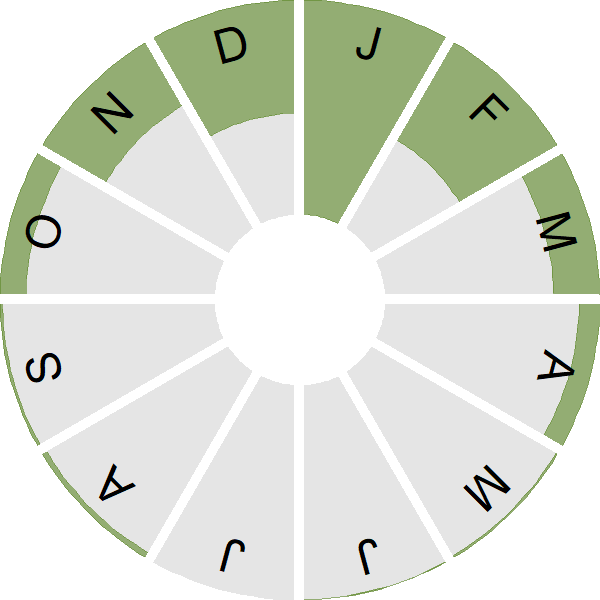Tundra Bean Goose

Introduction
Breeding in northern Siberia, the Tundra Bean Goose is a winter visitor to the UK in varying numbers.
Occurring in small groups, the appearance of Tundra Bean Geese in the UK is erratic but usually associated with cold weather on the Continent. Reflecting its Siberian origin, numbers of Tundra Bean Geese are higher in eastern England than elsewhere in the UK but, even in the east, single birds or small flocks of 10 or fewer are the norm.
BirdTrack records reveal a distinct peak in sightings during February and, whilst the species is particularly associated with eastern England, individuals can be found anywhere, particularly during cold weather when birds may move further south and west.

Key Stats
Identification
ID Videos
This section features BTO training videos headlining this species, or featuring it as a potential confusion species.
Grey Geese (Revisited)
Songs and Calls
Flight call:
Status and Trends
Conservation Status
Population Size
Population Change
Bean Goose was split into two distinct species - Tundra Bean Goose and Taiga Bean Goose - in 2017. There are two races of Tundra Bean Goose, but only the rossicus race is present in the UK in winter. Tundra Bean Geese rarely arrive in the UK before early January. They are widespread in their distribution across the UK, but there are rarely more than 50 across the country in any given winter Woodward et al. 2024. There is insufficient data to generate a population trend for this species.
Distribution
Small, but regular, numbers of Tundra Bean Geese are recorded each winter and these tend to be related to cold-weather movements from the near continent. The winter distribution map from 2007–11 shows concentrations along the British east coast, the Northern Isles, the Lancashire coast and inland around the Fens.
Occupied 10-km squares in UK
or view it on Bird Atlas Mapstore.
or view it on Bird Atlas Mapstore.
Distribution Change
Tundra Bean Goose has only recently been recognised as a full species meaning we cannot measure of map changes in distribution.
Seasonality
Tundra Bean Goose is a winter visitor, with numbers varying from year to year.
Weekly pattern of occurrence
The graph shows when the species is present in the UK, with taller bars indicating a higher likelihood of encountering the species in appropriate regions and habitats.

Movement
Britain & Ireland movement
European movements
EuroBirdPortal uses birdwatcher's records, such as those logged in BirdTrack to map the flows of birds as they arrive and depart Europe. See maps for this species here.
The Eurasian-African Migration Atlas shows movements of individual birds ringed or recovered in Europe. See maps for this species here.
Biology
Survival and Longevity
Survival is shown as the proportion of birds surviving from one year to the next and is derived from bird ringing data. It can also be used to estimate how long birds typically live.
Classification, names and codes
Classification and Codes
- Order: Anseriformes
- Family: Anatidae
- Scientific name: Anser serrirostris
- Authority: Gould, 1852
- BTO 2-letter code: XR
- Euring code number: 1574
Alternate species names
- Danish: Tundrasædgås
- Dutch: Toendrarietgans
- French: Oie de la toundra
- German: Tundrasaatgans
- Italian: Oca granaiola della tundra
- Latvian: tundras zoss
- Lithuanian: tundrine želmenine žasis
- Norwegian: Tundrasædgås
- Polish: ges tundrowa
- Slovak: hus tundrová
- Swedish: tundrasädgås
- Welsh: Gwydd Llafur y Twndra
Research
Causes of Change and Solutions
Causes of change
Across the Western Palearctic, the Tundra Bean Geese population is considered to be stable, therefore there are no causes of change to note.

